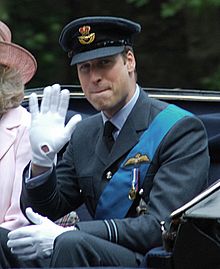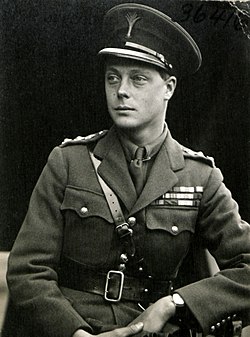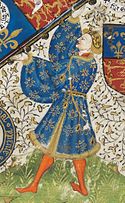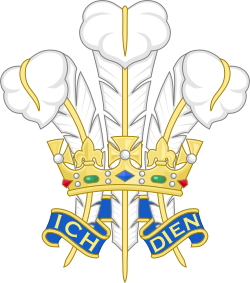Prins af Wales
| Prins af Wales Prince of Wales Tywysog Cymru | |
|---|---|
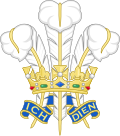 Prinen af Wales' fjer | |
| Tiltale | Kongelig Højhed |
| Bolig | Clarence House, London |
| Udnævner | Den britiske monark |
| Periodelængde | Livsvarig eller indtil tiltræden som monark |
| Første indehaver | Llywelyn den Store |
| Hjemmeside | www.princeofwales.gov.uk |
Prins af Wales (engelsk: Prince of Wales; walisisk: Tywysog Cymru; latin: Princeps Cambriae/Walliae) er en titel, som almindeligvis tildeles den engelske (siden 1707 britiske) tronfølger. Rettelig burde titlen oversættes som fyrste af Wales, men den forkerte oversættelse er med tiden blevet legio.
Prins William fik titlen af sin far Charles 3. af Storbritannien dagen efter dronning Elizabeth 2. af Storbritannien var død.
Lister over Prinser af Wales
Prins af Wales som walisisk titel
| Person | Navn | Arving til | Født | Blev prins af Wales | Stoppet som prins af Wales | Død |
|---|---|---|---|---|---|---|
| Dafydd ap Llywelyn | søn af Llywelyn ab Iorwerth | c. April 1212 | 11. april 1240; første dokumenterede brug 1244 | 25. februar 1246 | ||
 | Llywelyn ap Gruffudd | N/A søn af Gruffydd ap Llywelyn | c. 1223 | Efterfulgte Dafydd i 1246 som prince af Gwynedd; brugte titel "prins af Wales" fra 1258; anerkendt af Henrik 3. den 29. september 1267 | 11. december 1282 dræbt i kamp | |
| Dafydd ap Gruffydd | bror til Llywelyn ap Gruffudd | c. 1238 | 11. december 1282 | 3. oktober 1283 henrettet i Shrewsbury | ||
Prins af Wales som titel til den engelske eller britiske heir-apparent
| Person | Navn | Arving til | Født | Blev heir apparent | Blev prins af Wales | Stoppet som prins af Wales | Død |
|---|---|---|---|---|---|---|---|
 | Edward af Carnarvon | Edward I | 25. april 1284 | 19. august 1284 | 7 February 1301[1] | 7 July 1307 satte sig på tronen som Edward II | 21. september 1327 |
| Edward af Woodstock, den sorte prins | Edward III | 15. juni 1330 | 12. maj 1343[1] | 8. juni 1376 død | |||
 | Richard af Bordeaux | 6 January 1367 | 8. juni 1376 | 20 November 1376[1] | 22. juni 1377 satte sig på tronen som Richard II | 14. februar 1400 | |
 | Henry af Monmouth | Henry IV | 16. september 1386 | 30. september 1399 | 15. oktober 1399[1] | 21. marts 1413 satte sig på tronen som Henry V | 31. august 1422 |
 | Edvard af Westminster | Henry VI | 13. oktober 1453 | 15. marts 1454[1] | 11. april 1471 far afsat | 4. maj 1471 død | |
 | Richard Plantagenet, 3. hertug af York | 21. september 1411 | 25 October 1460 | 31. oktober 1460 | 30. december 1460 død | ||
 | Edward af York | Edward IV | 4. november 1470 | 11. april 1471 | 26. juni 1471[1] | 9. april 1483 satte sig på tronen som Edward V | 1483? |
 | Edvard af Middleham | Richard III | 1473 | 26. juni 1483 | 24. august 1483[1] | 31. marts eller 9. april 1484 død | |
 | Arthur Tudor | Henry VII | 20. september 1486 | 29. november 1489[1] | 2. april 1502 død | ||
 | Henry Tudor | 28. juni 1491 | 2. april 1502 | 18 February 1504[1] | 21. april 1509 satte sig på tronen som Henry VIII | 28. januar 1547 | |
 | Edward Tudor | Henry VIII | 12. oktober 1537 | –[1] | 28. januar 1547 satte sig på tronen som Edward VI | 6. juli 1553 | |
 | Henry Frederick Stuart | James I | 19. februar 1594 | 24. marts 1603 | 4. juni 1610[1] | 6. november 1612 død | |
 | Charles Stuart | 19. november 1600 | 6. november 1612 | 4. november 1616[1] | 27. marts 1625 satte sig på tronen som Charles I | 30. januar 1649 | |
 | Charles Stuart | Charles I | 29. maj 1630 | declared c. 1638–1641[1] | 30. januar 1649 titlen opgivet; senere (1660) satte han sig på tronen som Charles II | 6. februar 1685 | |
| James Francis Edward Stuart | James II | 10. juni 1688 | c. 4. juli 1688[1] | 11. december 1688[2] far afsat | 1. januar 1766 | ||
 | George Augustus | George I | 10. november 1683 | 1. august 1714 | 27. september 1714[1] | 11. juni 1727 satte sig på tronen som George II | 25. oktober 1760 |
 | Frederick Louis | George II | 1. februar 1707 | 11. juni 1727 | 8. januar 1729[1] | 31. marts 1751 død | |
 | George William Frederick | 4. juni 1738 | 31. marts 1751 | 20. april 1751[1][3] | 25. oktober 1760 satte sig på tronen som George III | 29. januar 1820 | |
 | George Augustus Frederick | George III | 12. august 1762 | 19. august 1762[1] | 29. januar 1820 satte sig på tronen som George IV | 26. juni 1830 | |
 | Albert Edward | Victoria | 9. november 1841 | 8. december 1841[1] | 22. januar 1901 satte sig på tronen som Edward VII | 6. maj 1910 | |
 | George Frederick Ernest Albert | Edward VII | 3. juni 1865 | 22. januar 1901 | 9. november 1901[4] | 6 May 1910 satte sig på tronen som George V | 20. januar 1936 |
 | Edward Albert Christian George Andrew Patrick David | George V | 23. juni 1894 | 6. maj 1910 | 23. juni 1910[1] | 20. januar 1936 satte sig på tronen som Edward VIII; senere (1937) hertug af Windsor | 28. maj 1972 |
 | Charles Philip Arthur George | Elizabeth II | 14. november 1948 | 6. februar 1952 | 26. juli 1958 | 8. september 2022 satte sig på tronen som Charles III | levende |
 | William Arthur Philip Louis | Charles III | 21. juni 1982 | 8. september 2022 | 9. september 2022[5] | Nuværende | |
Den længst siddende prins af Wales er var Charles III. Han er også den længst siddende heir apparent i britisk historie.[6]
Se også
- Prince of Wales-tern
Referencer
- ^ a b c d e f g h i j k l m n o p q r s t l Previous Princes. Prince of Wales official website. Retrieved on 15 July 2013.
- ^ Fortsatte med at bruge titlen indtil 1701
- ^ "The London Gazette - From Tuesday April 16, to Saturday April 26, 1751" (PDF). The London Gazette. No. 9050. 16. april 1751. s. 1. Hentet 2019-07-02.
- ^ .
You must specify issue= and startpage= when using {{LondonGazette}}. Available parameters: Skabelon:LondonGazette/doc/parameterlist
- ^ "William named the new Prince of Wales by King Charles III". BBC. 9. september 2022.
- ^ Bryan, Nicola (9. september 2017). "Prince Charles is longest-serving Prince of Wales". BBC.com. Hentet 11. september 2017.
| Spire Denne artikel om en kongelig eller fyrstelig person er en spire som bør udbygges. Du er velkommen til at hjælpe Wikipedia ved at udvide den. |
Medier brugt på denne side
The Prince of Wales (later King Edward VII)(1841-1910)
King Richard II of England (1367 - 1400). Head of the famous portrait shown in Westminster Abbey, London, where Richard is buried. It is the work of an unknown master, and the date is usually given as about 1390. This painting is the earliest known portrait of an English monarch, according to the Abbey's website.
Original caption: "
See source website for additional information.
This set of images was gathered by User:Dcoetzee from the National Portrait Gallery, London website using a special tool. All images in this batch have been confirmed as author died before 1939 according to the official death date listed by the NPG.George V of the United Kingdom (1865-1936)
George IV of the United Kingdom as the Prince Regent, circa 1814. He served as king of the United Kingdom of Great Britain and Ireland from 1820 to 1830. The Regency, George's nine-year tenure as Prince Regent, which commenced in 1811 and ended with George III's death in 1820, was marked by victory in the Napoleonic Wars in Europe.
----
George IV of the United Kingdom (1762-1830), Regent 1811-20; reigned 1820-30. Oil on canvas, 36 in. x 28 in. (914 mm x 711 mm), purchased, 1861, on display in Room 17 at the National Portrait Gallery.
Artist: (quoted from the National Portrait Gallery)
Sir Thomas Lawrence (1769-1830), Portrait painter, collector and President of the Royal Academy. Artist associated with 425 portraits, Sitter in 13 portraits.
In 1814, Lord Stewart, who had been appointed ambassador in Vienna and was a previous client of Thomas Lawrence, wanted to commission a portrait by him of the Prince Regent (later King George IV). He therefore arranged that Lawrence should be presented to the Prince Regent at a levée. Soon after, the Prince visited Lawrence at his studio in Russell Square. Lawrence wrote to his brother that To crown this honour, [he] engag'd to sit to me at one today and after a successful sitting of two hours, has just left me and comes again tomorrow and the next day. The result was a drawing in the Royal Collection, this dashing oil sketch of his head in profile like a Classical god and a large portrait of him in Field Marshall's uniform.
Edward VI of England
Edward, Prince of Wales, son of King Richard III and his Queen consort, Anne Neville. Cropped portion of, Richard III and family in the contemporary Rous Roll in the Heralds' College.
Forfatter/Opretter: Robert Payne, Licens: CC BY 2.0
His Royal Highness Prince William of Wales, RAF. Prince William is wearing the uniform of a flight lieutenant.
Edward I creating his son, the later Edward II, prince of Wales, 1301. Text reads "Eduuardus factus est princeps Wallie" (Edward is made prince of Wales).
Sculpture by Henry Pegram of Llywelyn the Last at City Hall, Cardiff, Wales.
King Charles II, by Adriaen Hanneman (died 1671). See source website for additional information.
This set of images was gathered by User:Dcoetzee from the National Portrait Gallery, London website using a special tool. All images in this batch have been confirmed as author died before 1939 according to the official death date listed by the NPG.Detail from the frontispiece of the illuminated manuscript Talbot Shrewsbury Book. In this detail Richard of York is shown supporting a giant fleur-de-lys, tracing the ancestry of Henry VI back to Saint Louis IX and justifying Henry's claim to the kingdom of France.
Forfatter/Opretter: Palácio do Planalto, Licens: CC BY 2.0
(Tóquio - Japão, 23/10/2019) Reunião Bilateral com o Príncipe Charles. Foto: José Dias/PR
Forfatter/Opretter: Sodacan, Licens: CC BY-SA 3.0
Ostrich feather Badge of the Prince of Wales
Arthur, Prince of Wales (1486-1502), wearing a collar composed of red and white Tudor roses and hat with a hat badge bearing the figure of St John the Baptist and two rosette-shaped cap hooks.
George II when Prince of Wales
